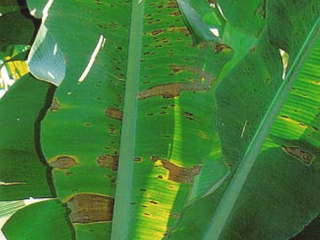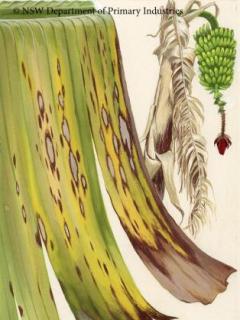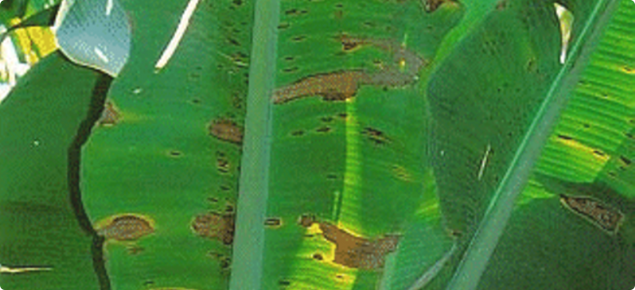The following diseases occur commonly and are of economic significance:
-
yellow sigatoka
-
banana speckle or leaf speckle
-
fruit speckle
-
corm rot/soft rot.
Yellow sigatoka (Mycosphaerelia musicola)

This fungal disease is characterised by the appearance of pale yellow streaks on the lower surface of leaves which enlarge into dark brown to black streaks. Advanced streaks merge into spots with a dark brown to black centre, often surrounded by a yellow halo.
Severe spotting may lead to defoliation, mixed ripe fruits and reduced bunch size. The disease is most noticeable at the end of the wet season on plantations that have not been sprayed with fungicides.
Control can be achieved with regular sprays of protectant fungicides, especially during wet summer months.
Banana speckle or leaf speckle (Mycosphaerella musae)
This fungal disease can be a problem from October to May. Infection occurs during wet periods and when there is water on the leaves for long periods.
Early symptoms can be seen first thing in the morning when the speckled infection on the leaves shows as irregular water soaked patches that ooze droplets of moisture or sap. Typical more advanced symptoms include general yellowing of leaves with dark brown or black speckled patches on the underside, which can look like glazy patches on the upper surface.
If the disease becomes severe, the leaves will die and drop off and small bunches with early and uneven ripening can result. The dead leaves have distinct grey speckled spots that stand out on the underside of the leaf. These are packed with spores ready to reinfect. Control is through protectant fungicides and having a regular monitoring and deleafing program.
Fruit speckle (Deightoniella torulosa)
Like leaf speckle, fruit speckle is a fungal disease that can be a problem from October to May. However, unlike leaf speckle, fruit speckle only infects fruit and does not infect the leaves of the growing plant. It survives on dead banana leaves in the plantation and during wet, humid weather the spores of the fungus are discharged into the air and lodge on the fruit where dark brown or black spots 2-4 mm in diameter develop within a few days.
The disease may be present on bunches at all stages of maturity. A photo and information can be found in the Agrilink Banana Information Kit.
Banana corm rot/soft rot (Erwinia carotovora/Erwinia spp.)
Corm rot affects the banana pseudostem at soil level producing a weakening effect that can cause the plant to fall over. The problem is caused by a soil bacterium that is often unnoticed until the plant falls. The first indication of disease is a soft black ring at soil level.
When the bacteria spreads, cavities are formed and these progress into the rhizome tissue and are lined with black rot that and can be colonised by various insects.
When the plant falls, it is usually due to the weight of the bunch because the central core rhizome tissue in most cases remains healthy. Subsequent ratoon suckers are not normally affected and will grow normally.
Registered fungicides
Fungicides registered for use in Western Australia on diseases present in the ORIA are listed below. Infopest has up-to-date information on what chemicals are registered.
| Common name | Scientific name | Product components currently registered in WA |
|---|---|---|
| Yellow sigatoka | Mycosphaerelia musicola | difenoconazole |
| Leaf speckle | Hycosphaerella musae | chlorothalonil |
| Fruit speckle | Deigntoniella torulosa | mancozeb |
| Banana corm rot/ | Erwinia carotovora/Erwinia spp. | Cu as cuprous oxide |
The table is only a guide to identify current registered chemicals that are suitable for managing banana diseases in the Ord River Irrigation Area.
For application rates and product registration details for Western Australia up-to-date information needs to be accessed. The information above was sourced from Infopest website that is updated regularly to provide accurate information. Registration is free.
Exotic diseases
The following diseases have been identified as a potential threat to the banana industry in the ORIA:
- Panama disease (Fusarium oxysporum)
- Banana blood disease (Ralstonia solanacearum)
- Black sigatoka (Mycosphaerella fijiensis)
- Moko disease (Ralstonia solanacearum)
- Banana bunchy top virus
- Banana streak virus.
Biosecurity
Due to the isolation of the ORIA strict biosecurity measures are imposed to stop introduction of diseases from other growing areas.
To avoid the introduction of more diseases it is imperative that the following biosecurity measures be adhered to:
- Only tissue culture material is allowed to be imported. That is, no bits from anywhere outside a 50km radius of the ORIA.
- Only purchase material from QBAN (Quality Banana Approved Nursery).
- All incoming material must be accompanied by the appropriate phytosanitary requirements paperwork.
For more information on the biosecurity requirements of importing planting material contact the local Quarantine Officer on 0429 088 130.

